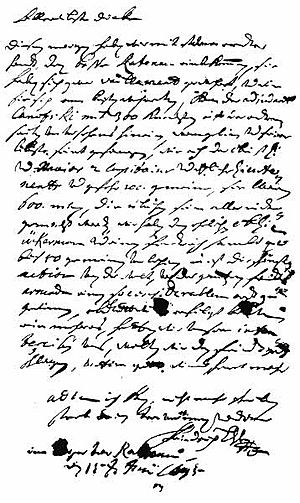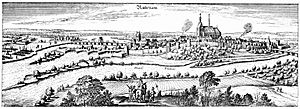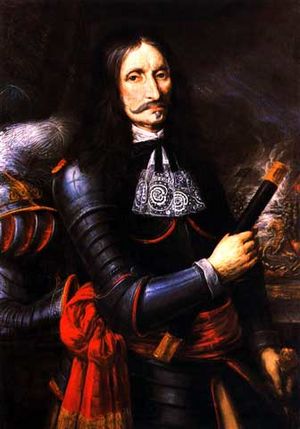Battle of Rathenow facts for kids
Quick facts for kids Battle of Rathenow |
|||||||
|---|---|---|---|---|---|---|---|
| Part of Swedish-Brandenburg War | |||||||
|
|||||||
| Belligerents | |||||||
| Commanders and leaders | |||||||
| Colonel Wangelin | Field Marshal Georg von Derfflinger General von Götze |
||||||
| Strength | |||||||
| 500, of which 70 men sick | 8,000 of which 1,500–2,000 engaged | ||||||
| Casualties and losses | |||||||
| 200 killed 270 captured |
100 killed and mortally wounded | ||||||
The Battle of Rathenow was the first big fight between the armies of Brandenburg-Prussia and Sweden. It happened during a larger conflict known as the Swedish-Brandenburg War, also called the Scanian War.
This battle took place on June 15, 1675. It ended with Brandenburg troops capturing the town of Rathenow. The Swedes had been holding the town.
About 500 Swedish soldiers, led by Colonel Wangelin, were in Rathenow. The Brandenburg army had around 1,500 to 2,000 men. They were commanded by Field Marshal Georg von Derfflinger and General von Götze.
Contents
Why Did the Battle of Rathenow Happen?
In 1674, Brandenburg joined the Franco-Dutch War against France. They sent a large part of their army to fight in a place called Alsace. Because Brandenburg's main army was away, France convinced Sweden to attack Brandenburg.
Swedish troops marched from Swedish Pomerania into Brandenburg in late 1674. They didn't face much resistance because most of Brandenburg's soldiers were fighting France. The Swedes, led by Field Marshal Wrangel, took over the city of Brandenburg. They also occupied the town of Rathenow.
The Swedes wanted to cross the River Elbe at Havelberg. From there, they planned to join forces with other troops. Their main goal was to capture the important fortress of Magdeburg. Colonel Wangelin's Swedish soldiers occupied Rathenow to control the river crossings. They needed to secure these crossings before moving on to Magdeburg.
Meanwhile, the Elector of Brandenburg, Frederick William, wanted to stop the Swedish advance. He planned to attack the Swedish army from behind. He also wanted to connect with his own troops at the Magdeburg fortress.
How Did the Ambush of Rathenow Unfold?
The town of Rathenow was on the east side of the Havel River. A wide marshy area protected it from the west. The town also had a moat around it. Its old medieval walls were not perfect, but they still offered good protection. The town gates had strong defenses and drawbridges.
The Brandenburg plan was to attack the town through its western gate, called the Havel Gate. Field Marshal Georg von Derfflinger led his troops towards the gate just before 2 AM. Derfflinger had served with the Swedes for many years during the Thirty Years' War. He rode ahead with only a few dragoons (soldiers on horseback).
He spoke fluent Swedish to the guards at the gate. He pretended to be a Swedish lieutenant who was running from Brandenburg troops. This trick worked, and the guards lowered the drawbridge. This allowed the dragoons to rush into the town. Other stories say Derfflinger rode alone to the gate. Once it was open, his dragoons quickly followed to surprise the Swedes.

At the same time, the Elector sent Major General von Götze with 600 musketeers. They advanced along the mill embankment to the Mill Gate. Heavy fighting started there. The Swedes used the town's defenses to hold their ground for a while. Another Brandenburg unit tried to enter the south side of the town by boat. They were also pushed back at first.
However, the Brandenburgers attacked again and succeeded. The assault on the Mill Gate also worked, and General von Götze captured it. After fierce fighting, the Swedish soldiers were defeated. Their commander, Colonel Wangelin, surrendered.
"My dearest, this morning we have taken the base of Ratenau by storm; they did indeed defend valiantly and, as they were fighting at their best, Adjutant Canolski entered by the side unobserved with 300 men. Wangelin and his comrades are taken prisoner, as well as the lieutenant colonel and major, 2 captains and some lieutenants, and about 100 men. They had 600 in all, the rest were all killed. We have lost the honorable Lt. Col. Ückermann and an ensign, together with 40 to 50 other ranks, it is the best operation in the world to capture such an important place in front of all the enemy armada. If God had wanted us to do more, had we had our infantry with us, we would have beaten the enemy soundly, in the end God wanted some to survive. Adieu, I can write no more. I die your faithful husband and your servant."
—Frederick L. z. Hesse, letter to his wife
What Was the Outcome of the Battle?
The Battle of Rathenow was a big loss for Sweden. They had 200 soldiers killed and 270 captured. The Brandenburg troops lost only 100 men who were killed or badly wounded. They also captured 500 to 600 horses from the Swedes.
Before this battle, many people thought the Swedish army was unbeatable. But this defeat showed they could be beaten. Because of this loss, the Swedes had to give up their plan to cross the Elbe River near Rathenow. They had wanted to attack the important Magdeburg from there.
The Swedish army didn't know how strong the Brandenburg forces were. So, they had to quickly retreat north to protect their supply lines. Over the next few days, the Brandenburg army chased them. This retreat turned into a messy escape. It finally ended three days later, on June 28, with a major defeat for the Swedes at the Battle of Fehrbellin.
See also
- Wars and battles involving Prussia



